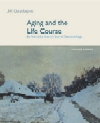1. What is the theory of cumulative disadvantage and how does it explain
gender, racial, and ethnic differences in material well-being among the aged?
The basic sociological approach to stratification views inequality as a product
of social processes, not innate differences between individuals. The central
question in the study of stratification is how social inequality is produced,
maintained, and transmitted from one generation to another. According to the
theory of cumulative disadvantage, inequality is not a static outcome but rather
is a cumulative process that unfolds over the life course. Women and members
of racial and ethnic minorities have lower incomes and higher rates of poverty
in old age than white males because of earlier experiences and opportunities. 2. How do gender and marital status affect a person's eligibility for
Social Security benefits?
Social Security is an important source of income for nearly all older people,
but those at the lower end of the income distribution-women and minorities-depend
most on this program. Yet their average benefits are lower than those of white
men. Women and minorities receive lower Social Security benefits than white
males, because the eligibility rules reward workers who have had continuous
work histories and high-paying jobs. Women and minorities have more sporadic
records of labor force participation and lower wages than white men. As a result,
their benefits tend to be lower. The gender disparity in Social Security benefits
may diminish in the future. One reason is that women are working more steadily
than in the past. When they reach retirement age, they will have had more continuous
work histories. Another reason is that the job stability of white males has
declined. Finally, the pay gap between younger men and women has declined. 3. How does the Social Security benefit for spouses operate?
The spouse benefit supplements the retirement income of a married couple by
providing one-half of the retired worker's benefit. When the worker dies, the
widow or widower loses the spouse benefit but retains a survivor's benefit equal
to 100 percent of the worker' benefit. A former spouse is eligible for one-half
of the worker' benefit but not until she or he reaches age 60. 4. How do gender and marital status affect a person's eligibility for
employer pensions?
The same factors that reduce Social Security benefits for women and minorities
also affect their access to employer pensions. Low wages and discontinuous work
histories make many people ineligible for these pensions. The advantage of Social
Security, however, is that nearly 99 percent of older people (as mentioned in
Chapter 4) receive some income from it. By contrast, less than half of retirees
receive income from employer pensions. 5. How do racial and ethnic groups vary in terms of their economic
security in old age?
Compared to whites, African Americans have had higher rates of unemployment,
more sporadic employment, and lower wages. Lower earnings during their working
years mean lower Social Security benefits in retirement. Sporadic employment
also means less opportunity to become vested in private pension systems and
less opportunity to accumulate pension savings. Because of past and continuing
discrimination in the sale of housing, older blacks and Hispanics are less likely
than whites to own a home. Further, because of segregated housing patterns,
the homes owned by blacks are less valuable than those of whites. Among the Hispanic aged, poverty rates vary by country of origin. They are
highest among Puerto Ricans, relatively high among Mexicans, and just slightly
more than whites among Cubans. The Asian American aged are the most prosperous
group of immigrants. They have the highest median family income, lowest poverty
rates, and highest rates of home ownership. American Indians have the highest
unemployment rates and the highest mortality rates of any minority. The high
levels of poverty among elderly American Indians reflect the results of more
than a century of federal policy toward indigenous people. The federal government
has the responsibility for providing health care for American Indians. |



 2002 McGraw-Hill Higher Education
2002 McGraw-Hill Higher Education